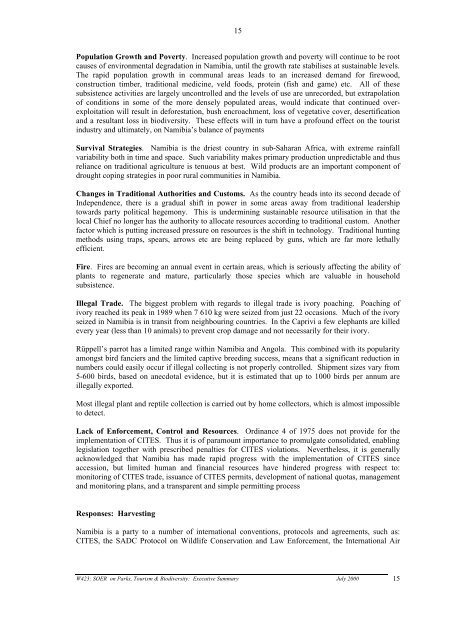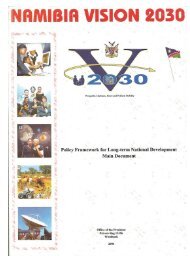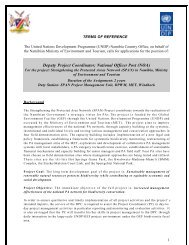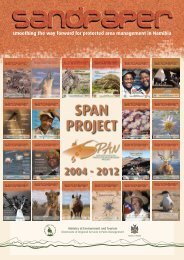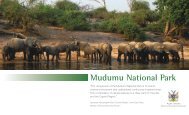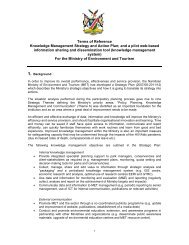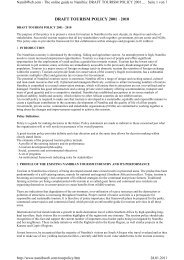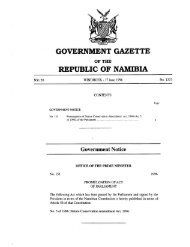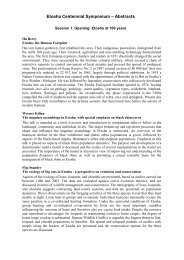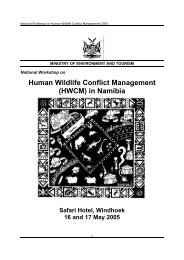EXECUTIVE SUMMARY - Ministry of Environment and Tourism
EXECUTIVE SUMMARY - Ministry of Environment and Tourism
EXECUTIVE SUMMARY - Ministry of Environment and Tourism
You also want an ePaper? Increase the reach of your titles
YUMPU automatically turns print PDFs into web optimized ePapers that Google loves.
15<br />
Population Growth <strong>and</strong> Poverty. Increased population growth <strong>and</strong> poverty will continue to be root<br />
causes <strong>of</strong> environmental degradation in Namibia, until the growth rate stabilises at sustainable levels.<br />
The rapid population growth in communal areas leads to an increased dem<strong>and</strong> for firewood,<br />
construction timber, traditional medicine, veld foods, protein (fish <strong>and</strong> game) etc. All <strong>of</strong> these<br />
subsistence activities are largely uncontrolled <strong>and</strong> the levels <strong>of</strong> use are unrecorded, but extrapolation<br />
<strong>of</strong> conditions in some <strong>of</strong> the more densely populated areas, would indicate that continued overexploitation<br />
will result in deforestation, bush encroachment, loss <strong>of</strong> vegetative cover, desertification<br />
<strong>and</strong> a resultant loss in biodiversity. These effects will in turn have a pr<strong>of</strong>ound effect on the tourist<br />
industry <strong>and</strong> ultimately, on Namibia’s balance <strong>of</strong> payments<br />
Survival Strategies. Namibia is the driest country in sub-Saharan Africa, with extreme rainfall<br />
variability both in time <strong>and</strong> space. Such variability makes primary production unpredictable <strong>and</strong> thus<br />
reliance on traditional agriculture is tenuous at best. Wild products are an important component <strong>of</strong><br />
drought coping strategies in poor rural communities in Namibia.<br />
Changes in Traditional Authorities <strong>and</strong> Customs. As the country heads into its second decade <strong>of</strong><br />
Independence, there is a gradual shift in power in some areas away from traditional leadership<br />
towards party political hegemony. This is undermining sustainable resource utilisation in that the<br />
local Chief no longer has the authority to allocate resources according to traditional custom. Another<br />
factor which is putting increased pressure on resources is the shift in technology. Traditional hunting<br />
methods using traps, spears, arrows etc are being replaced by guns, which are far more lethally<br />
efficient.<br />
Fire. Fires are becoming an annual event in certain areas, which is seriously affecting the ability <strong>of</strong><br />
plants to regenerate <strong>and</strong> mature, particularly those species which are valuable in household<br />
subsistence.<br />
Illegal Trade. The biggest problem with regards to illegal trade is ivory poaching. Poaching <strong>of</strong><br />
ivory reached its peak in 1989 when 7 610 kg were seized from just 22 occasions. Much <strong>of</strong> the ivory<br />
seized in Namibia is in transit from neighbouring countries. In the Caprivi a few elephants are killed<br />
every year (less than 10 animals) to prevent crop damage <strong>and</strong> not necessarily for their ivory.<br />
Rüppell’s parrot has a limited range within Namibia <strong>and</strong> Angola. This combined with its popularity<br />
amongst bird fanciers <strong>and</strong> the limited captive breeding success, means that a significant reduction in<br />
numbers could easily occur if illegal collecting is not properly controlled. Shipment sizes vary from<br />
5-600 birds, based on anecdotal evidence, but it is estimated that up to 1000 birds per annum are<br />
illegally exported.<br />
Most illegal plant <strong>and</strong> reptile collection is carried out by home collectors, which is almost impossible<br />
to detect.<br />
Lack <strong>of</strong> Enforcement, Control <strong>and</strong> Resources. Ordinance 4 <strong>of</strong> 1975 does not provide for the<br />
implementation <strong>of</strong> CITES. Thus it is <strong>of</strong> paramount importance to promulgate consolidated, enabling<br />
legislation together with prescribed penalties for CITES violations. Nevertheless, it is generally<br />
acknowledged that Namibia has made rapid progress with the implementation <strong>of</strong> CITES since<br />
accession, but limited human <strong>and</strong> financial resources have hindered progress with respect to:<br />
monitoring <strong>of</strong> CITES trade, issuance <strong>of</strong> CITES permits, development <strong>of</strong> national quotas, management<br />
<strong>and</strong> monitoring plans, <strong>and</strong> a transparent <strong>and</strong> simple permitting process<br />
Responses: Harvesting<br />
Namibia is a party to a number <strong>of</strong> international conventions, protocols <strong>and</strong> agreements, such as:<br />
CITES, the SADC Protocol on Wildlife Conservation <strong>and</strong> Law Enforcement, the International Air<br />
W423: SOER on Parks, <strong>Tourism</strong> & Biodiversity: Executive Summary July 2000 15


